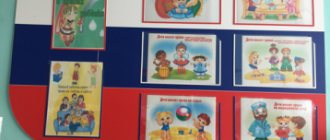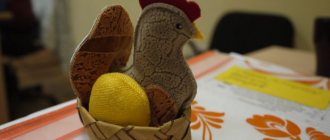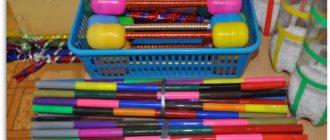Methodological recommendations for educators “Methodology and organization of group gatherings”
Author: Frolova Ksenia Ivanovna
senior teacher of the MDOU Kindergarten “Ogonyok” r.p. New Igirma
Methodological recommendations for educators “Methodology and organization of group gatherings”
Methodological recommendations for educators
“Methodology and organization of group gatherings”
Frolova K.I., senior teacher
MDOU Kindergarten "Ogonyok" r.p. New Igirma
One of the conditions for the implementation of the Federal State Educational Standard for preschool education is to support the individuality and initiative of children. Based on this, the educational process in preschool educational institutions must be built taking into account the individual characteristics of each child.
Individualization of education is based on supporting children in the development of their potential, stimulating children’s desire to independently set goals and achieve them in the process of learning. All children have individual characteristics that the teacher should identify and take into account in order to ensure optimization of the learning and development process.
One of the effective forms of work to support children's individuality and initiative is a group gathering.
A group gathering is part of the daily routine, held at a certain time, in a specially equipped place, when children and adults exchange information, discuss problems, plan individual and joint activities, share impressions, sing, play, laugh.
In the broadest sense, a group gathering is intended to provide the opportunity for the constructive, cognitive and business development of children in a situation of natural socio-emotional communication with peers and adults, to develop skills in understanding oneself and others, and to coordinate the purposeful activities of the entire group and each child in separately.
There may be several group gatherings during the day: morning gathering (morning circle) and final gathering (evening circle).
The morning meeting is a kind of “children’s planning meeting.”
The main purpose of the morning meeting is to “set the tone” for the whole day, that is, to create a positive emotional mood and instill in the child confidence that he will feel good among his peers, and that the day promises to be interesting and eventful.
Morning assembly solves a number of educational problems:
- establishing a comfortable, socio -
psychological climate; - exchange of information about past or upcoming events;
- formation of motivation for upcoming activities;
- providing information about materials in activity centers for the current day and planning activities in the centers;
- making a choice of activities based on one’s own interests and needs;
- establishing belonging and community between children and adults of the group.
Morning collection is recommended after breakfast. Under no circumstances should it be too long! The duration of the morning gathering depends on the age characteristics of the children. For most children 3-4 years old, the maximum period of time is from 5 to 10 minutes. For children of middle preschool age this period is from 10 to 15 minutes, for children of senior preschool age 15-20 minutes. It is best to devote only a few minutes to morning assembly at the beginning of the school year, gradually increasing its duration.
It should be remembered that morning gathering should be short, businesslike and fun, the main thing is not to turn it into a routine and boring task.
Technologically, group gatherings are easy to conduct and easily accepted by educators and children of any age. You need to start preparing for the morning gathering by choosing a convenient place where you can sit down with the whole group. There should be enough space to sit freely in a circle. Children can sit on a carpet or soft surface, on cushions or in chairs. The main thing is that children feel comfortable.
Near the meeting place, there should be a place for a working panel (working wall or information field), on which the calendar, topic of the week, information on this topic and news of the day are posted. It is important to ensure that the height of the location, ease of approach, safety and ease of fastening materials correspond to the capabilities of children.
Next, we will agree on a signal that will announce the start of the collection. This could be a melody, a group's favorite song, the ringing of a bell, or any sound signals or flashing lights. One or more of these signals may be used throughout the year. The teacher can entrust the choice of call signs to the children themselves.
At the beginning of the school year, it is important to discuss and establish rules for morning assembly. One of the best ways to maximize children's compliance with rules is to involve children themselves in defining the rules, changing them, and adopting new rules as the need arises. Children's acceptance of a rule that they have developed themselves creates a sense of ownership and responsibility for its observance. The rules are written not only verbally (written in large block letters), but also in the form of drawings or symbols. The rules are posted on the work wall near the morning meeting area and serve as a visible reminder of the agreed upon standards of behavior. The rules, regardless of their content, are always formulated positively: “We listen carefully to others” (and not “Don’t interrupt others”), “You can shout and run in the street” (and not “Don’t shout”, “You can’t run”).
By accepting rules for the whole group, children follow them themselves - this contributes to the development of independence and responsibility.
Morning gathering traditionally consists of four basic components:
- Greeting is
a simple and interesting ritual by which morning gathering participants greet each other. The greeting should be addressed to each member of the group, it can be verbal or non-verbal. As a greeting, you can use songs, chants, game moments, greetings in different languages, pantomime images, touching palms, shoulders, elbows, greetings in poetic form, with compliments, etc. All this gives a positive attitude, promotes mutual understanding and mutual respect. - A game.
Any games that do not require great mobility are played: finger games, verbal games, fantasy games, chain games, joke games, training elements (psycho-gymnastics). It is important that games are conducted as games and not as learning activities. - Exchange of news.
This is a responsible and significant stage of morning gathering. At this stage, children share news - events at home, successes - failures, childhood grievances and achievements, and discuss issues that seem important to them. While sharing news, children get the opportunity to learn more about each other, gain experience in public speaking, and learn to listen to others.
Exchange of news is a time for legitimate expression of everything that fills the soul. There are no taboo topics; news is accepted as fact.
At this stage, it is important to determine the rules for the order of statements. Since if not everyone, then many, want to speak out, it is worth initially discussing and introducing the rule: “We speak one at a time,” or “The one who is holding the microphone (magic wand, ball) speaks.” It is advisable to introduce a rule at a time when children, having tried to make their way through the noise, themselves feel that they are not being heard, that it is inconvenient.
To avoid and prevent noise and inconvenience during the morning gathering, you can use some “tricks”:
- Before the morning gathering begins, attach a sign (bow, medal, bracelet) to one of the children, put a bean or pine cone in their pocket. These guys will have the right to be the first to tell about their news.
- For several children, place an object under their pillow, such as a cut-out paper heart or a paper bird - a “magpie that brings news.”
- If you know that one of the guys has news that is significant for everyone (birthday, dad’s return from a business trip, etc.), or you see that someone is looking forward to starting a conversation, give him the right to speak first .
Sometimes allow children to play the role of educator and give them the right to decide who will talk about the news.
The most difficult part of sharing news for a teacher is responding to the statement. A universal technique for stopping the discussion of something unpleasant or unwanted is to calmly and confidently say “it happens.”
At this stage of the morning gathering, a discussion of the news of the day takes place. The news of the day is a short message written in large block letters and posted on the work wall. This message includes plans for the day or announces interesting events in the group, such as the arrival of a guest or an upcoming field trip. The teacher, reading the text of the news to the children, points with his hand to each of the words as he reads. The news of the day is an opportunity to develop reading and writing skills.
- Presentation of activity centers, day planning
(selection of activity centers, activity planning)
The teacher tells and shows the children what materials are prepared today in the activity centers. Using a choice board or choice wheel, the child chooses the center in which he wants to be today and explains what he will do.
A choice board is one of the options for organizing independent activities for children. It is a set of pictograms indicating a particular center. Together with the teacher, children choose pictograms to indicate centers in the group where it would be interesting for preschoolers to be and engage in some activity. There are pockets under each pictogram. Then the teacher, together with the children (and at their request), makes a special badge for each child or uses a photograph of the child. Having chosen an activity, children place badges in the appropriate pockets. Each child shows initiative and independence by choosing their own activity center.
Every day, at the end of the day, after the children have completed their plans - they have implemented their plan in some activity center, a final gathering is held with the children (evening gathering). Summary collection is another form of group collection.
The task of the final gathering is to organize the process of reflection; demonstrate the overall results of the day’s work, discuss what worked, what didn’t work, and outline next steps. And another equally important task is to instill enthusiasm and instill in children a sense of confidence that they, too, can do well if they want.
The role of the teacher is extremely important in organizing and activating the process of reflection, in supporting children’s positive self-esteem of their achievements and prospects, and their influence on the overall situation in the group.
It is important for the teacher to remember that a group gathering is not an activity! Group time should not be used to teach children specific skills.
Each element of a group gathering allows preschoolers to master a range of social skills and develops the intellectual, emotional and social skills of each group member. These are lessons in kindness, empathy, and partnership that lead to great results both within and outside the group.
Teachers should be interested in holding group meetings as an important means of modeling friendly, democratic behavior within the children's team.
Literature:
- Debbie Cryer. Guidelines. For working with children 3-5 years old / Translation from English. – M.: MOSAIC – SYNTHESIS, 2022. – 80 p. (Program based on ECERS).
- Svirskaya L.V. Morning of joyful meetings. – “Linka – Press”, 2010. – 121 p.
- Colleen Bain. Project “Hello! I'm glad to see you!". Manual for teachers “Morning Assembly” / – Childrens Resources International, Inc. Copyright 2004. – 56 p.
- Yudina E.G., Bodrova E.V. An approximate basic general education program for preschool education “PROChildren”. – Moscow, 2022. – 136 p.
Methodological recommendations for educators “Methodology and organization of group gatherings”






